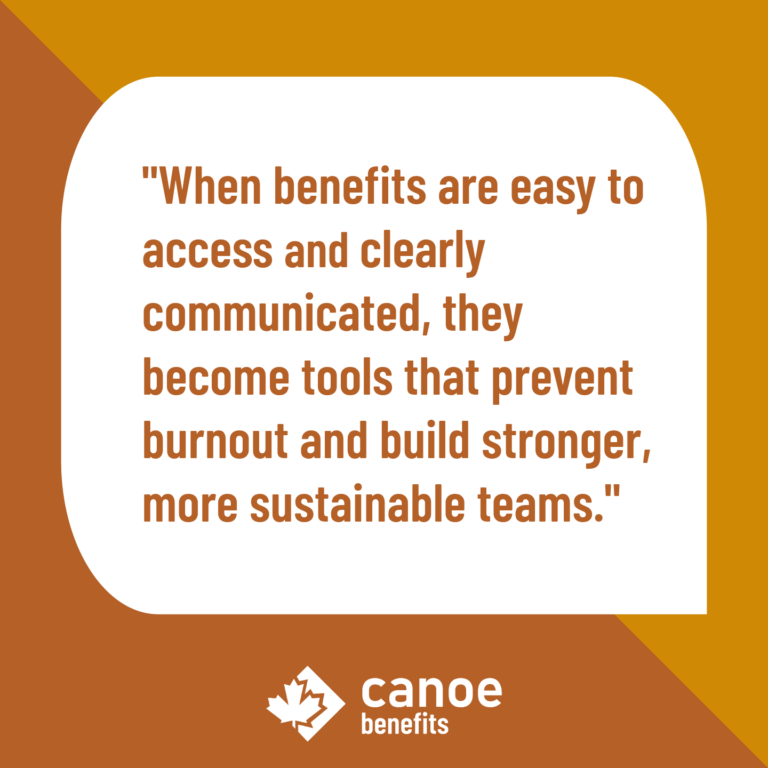By Canoe Benefits
The final stretch of the year can test even the most resilient teams. Deadlines stack up, inboxes fill faster than they empty, and many employees juggle heavier workloads alongside family commitments and holiday planning. It’s a season that demands a lot, both mentally and emotionally, and it can quietly drain energy from teams that have worked hard all year.
That slow drain is what often turns into burnout. It rarely happens overnight. It builds through small signs like fatigue, distraction, irritability, or simply feeling detached from the work. For leaders and HR professionals, this is the right moment to step back and ask how their organization is supporting employee well-being before the year officially wraps up.
Realizing When Energy Is Running Low
The signs of burnout don’t always stand out. Some employees might power through and hide their stress, while others may grow quieter, miss small details, or disengage during team meetings. These shifts in behavior often reveal that someone’s reaching their limit.
Creating space for meaningful check-ins can make a real difference. That doesn’t mean adding another meeting. It can be as simple as opening the door for honest conversation or asking about workload before diving into updates. Genuine curiosity and empathy help employees feel safe to share what’s actually going on.

Reducing End-of-Year Pressure
A heavy workload can’t always be avoided, but it can be managed more intentionally. November is a good time to re-evaluate what truly needs to be completed before year-end. Look at what can wait, where projects can be simplified, and whether any deadlines are self-imposed rather than essential.
Teams tend to work better when expectations match the time and energy available. That doesn’t mean lowering the bar. It means creating a realistic plan that supports both productivity and employee well-being.
A few small changes can help reduce stress:
- Reassess priorities and cut non-urgent tasks
- Consolidate recurring meetings to free up focus time
- Encourage leaders to model balanced workloads and take breaks
When leaders show that it’s okay to pause, others tend to follow.
Reconnecting Employees With Their Benefits
End-of-year burnout often rises because employees forget what tools are already available to help them. Most organizations have group benefits that include valuable resources for mental and physical health, but not everyone knows how to access them, or even what’s covered.
This is the perfect time to remind teams about the resources that support employee well-being, such as:
- Mental health counselling or therapy coverage
- Employee Assistance Programs (EAPs) for short-term guidance
- Virtual care for quick and convenient support
- Preventive health services like massage, physiotherapy, or fitness coverage
A short email or quick mention during team meetings can make these benefits feel more accessible. Employees shouldn’t have to search through long documents or intranet pages to find help. The easier it is to access, the more likely they’ll use it before stress takes hold.
If your organization needs help reviewing how benefits are communicated, your Canoe advisor can help identify small updates that make a big difference.
Encouraging Real Rest
Time away from work is one of the simplest ways to prevent burnout, yet it’s often the most overlooked. Many employees save vacation days for the holidays or worry about leaving tasks unfinished. Encouraging people to take their remaining days, even just a long weekend, can make the final months of the year more manageable.
Leaders can normalize rest by using their own vacation time and talking openly about it. Clear boundaries around email, meeting coverage, and workload during absences also help employees fully disconnect instead of checking in from home.
Movember and the Mental Health Conversation
And since November is also Movember, it’s a timely reminder to consider how burnout shows up differently for men. While men might be less likely to talk openly about mental health struggles, that doesn’t mean they aren’t experiencing them. Long hours, caregiving responsibilities, financial stress, and expectations around productivity can all take a toll.
Creating space for honest conversations, sharing available resources, and normalizing mental health care for everyone on your team makes a real difference. Even a simple check-in or casual reminder that it’s okay to ask for help can help shift your culture in a meaningful way.
Reflecting Before the Reset
Before heading into the new year, it’s worth asking what worked well this year and where things started to feel heavy. Were workloads balanced? Did communication feel clear? Did the team feel supported through busy seasons? Taking time to reflect creates awareness that can help prevent burnout in the future.
This reflection also ties into employee well-being planning for the year ahead. Benefits, policies, and communication strategies evolve best when they’re informed by lived experience. The end of the year is a natural checkpoint for gathering that insight.
Your Canoe advisor can help review your benefits communication, identify opportunities for improvement, and share resources that make wellness support easier to use.
A few small, thoughtful actions this month can help employees head into the holidays feeling grounded instead of drained. That’s the kind of energy that builds stronger, more sustainable teams and sets everyone up for a healthier start to the new year.
